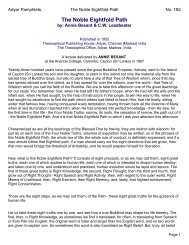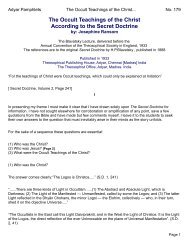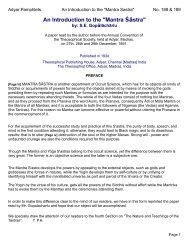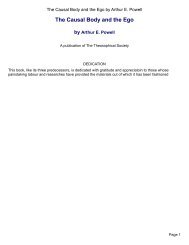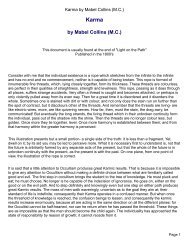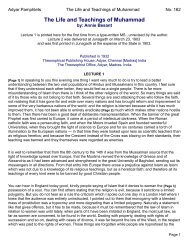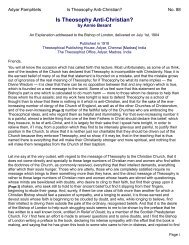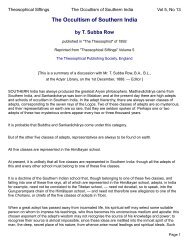The Theosophical Seal - Canadian Theosophical Association
The Theosophical Seal - Canadian Theosophical Association
The Theosophical Seal - Canadian Theosophical Association
Create successful ePaper yourself
Turn your PDF publications into a flip-book with our unique Google optimized e-Paper software.
<strong>The</strong> <strong>The</strong>osophical <strong>Seal</strong> by Arthur M. Coon<br />
Primer of Higher Space, following Hinton's and Ouspensky's works on higher dimensional space and its<br />
relationship to life. Lines, angles and curves, forming every conceivable geometric pattern in complex<br />
combinations and arrangements are designed to show that the outer world of Nature and the inner world<br />
of Spirit are intimately and intricately interrelated. This interrelationship between the inner and the outerthe<br />
Noumenon and the phenomena- finds it expression through geometric figures. <strong>The</strong>y have called it a<br />
new Symbology of the spiritual life. <strong>The</strong> idea behind this form of expression is that invisible forcesincluding<br />
thought and emotion- produce vibrations in the rarer media which surrounds us and which may<br />
be caught or fixed, so to speak, in a particular series of geometric figures. Music , the most etherial or<br />
fluid of the arts, might thus be compressed or frozen within a composite figure made up of cubes,globes,<br />
tetrahedrons,pentahedrons, etc., fantastic arrangements. <strong>The</strong> term"Architecture is frozen music" became<br />
a popular expression. This term really originated a century earlier by the German Neo-Platonic<br />
philosopher Frederick Von Schelling (Philosophie der Kunst, pages 576- 593). <strong>The</strong> idea of interpreting<br />
the universe and life in terms of mathematics has been taken up by modern philosophers, with the<br />
benefit of the advanced science of physics, and forms an approach to the subject which has a close tie-in<br />
with science itself.<br />
Manly P.Hall, in his "Symbolism, the Universal Language". (Lectures on Ancient Philosophy") makes<br />
some interesting observations on the meanings of lines, curves, angles, etc.. Writing about caricatures,<br />
he shows that every phase and degree of human emotions and character may be portrayed by the<br />
correct usage of lines. By the convex, concave or angular lines,little idiosyncrasies of character may be<br />
emphasized out of their normal proportions, depicting personal traits otherwise unsuspected. As every<br />
artist knows, lines,-horizontal, vertical, oblique, convex and concave- as applied to the human face (and<br />
figure) tell a story beyond the power of words. Today this art has a universal appeal through the medium<br />
of the cartoon. Wit, satire and criticism, through the art of suggestion, become by far more potent than<br />
direct statement- and avoid the danger of incrimination. <strong>The</strong> language of lines may be summarized<br />
briefly: straight lines and angles denote strength and are therefore masculine; curved lines and arcs<br />
express beauty and suggest the feminine.<br />
Symbolism plays an important part in the world's great literature, particularly Oriental literature. Myth ,<br />
allegory, parable and glyph are universally recognized techniques in portraying- and preserving- spiritual<br />
or philosophic truths. Some of the most profoundly beautiful literature the world has ever known, written<br />
thousands of years before the Christian era, comes to us from India, cradle of the ancient Aryan race.<br />
<strong>The</strong> Puranas, Upanishads and Gita contain not only the supreme laws of the spiritual life and rules for<br />
attaining union with God, but also the story of cosmogenesis- of the creation and evolution of the<br />
universe and of man. All of this is told in epic form, using allegory and myth. In what better way could the<br />
sublimity of these truths have been preserved over the thousands of years of the infancy of the human<br />
race Our own Bible is an outstanding example. Serious and sincere students agree that many of the<br />
stories of the Bible are meaningless, not to say fantastic, unless interpreted in the light of symbolism: <strong>The</strong><br />
Serpent and the Garden of Eden, Noah's Ark, Jonah in the Whale's Belly, Joshua and the Walls of<br />
Jericho - to mention a few which everyone knows. To translate these remarkable stories as history is to<br />
miss completely the profound truths so thinly veiled. Symbolically, we may read in them the pilgrimage of<br />
the human soul through its rounds of manifestation, the cosmogenesis of life and form in our solar<br />
system, the way of perfection and the eventual reunion of man with God. <strong>The</strong> greatest tragedy of<br />
Christendom is the blunder of the western world in having read its sacred scriptures only as history or<br />
geography. It seems most appropriate to insert here another quotation from Manly Hall: "Symbols are<br />
formulated to clarify truths which in their abstract form are incomprehensible. Idolatry consists in the<br />
inability of the mind to differentiate between the symbol and the abstract principle for which it stands".<br />
Page 8



